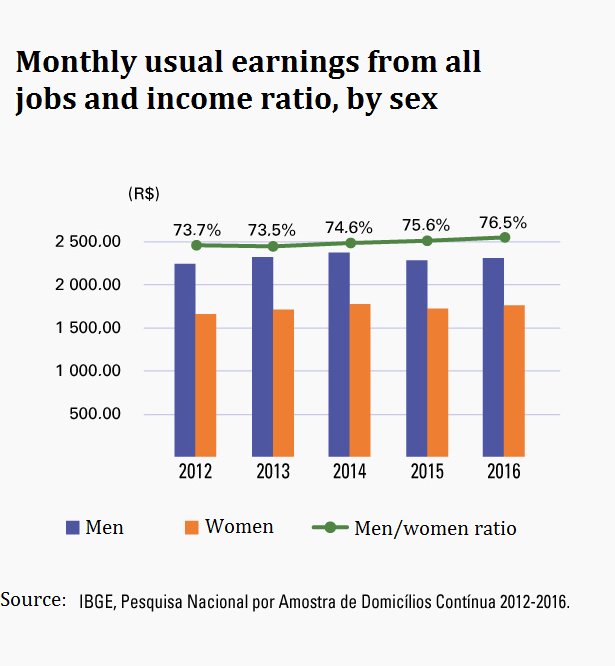Women study more, work more and earn less than men
March 07, 2018 10h00 AM | Last Updated: March 08, 2018 03h33 PM
Women work, on average, three hours a week more than men, combining paid work, household chores and caretaking. Even so, although with higher schooling, they earn, on average, 76.5% of men's income. This and further information are in the study Gender Statistics, released today by IBGE.
More hours, less pay
Several factors contribute to the differences between men and women in the labor market. For example, in 2016, women spent an average of 18 hours a week caring for people or doing household chores, 73% more than men (10.5 hours). This difference reached 80% in the Northeast (19 against 10.5). This explains, in part, why the proportion of women employed in part-time jobs (up to 30 hours a week) is twice as many as men (28.2% of employed women, compared to 14.1% of men).
"As a result of the burden of chores and caretaking, many women feel compelled to seek fobs with more flexible hours," explains the coordinator of Population and Social Indicators IBGE, Barbara Cobo, adding that "even with part-time jobs, women work more. Combining the hours of paid work with those of careting and chores, women work, on average, 54.4 hours a week, against 51.4 for men. "

Even while working longer hours, women keep earning less. Although the difference between men's and women's earnings has declined in recent years, in 2016, female workers still earned the equivalent of 76.5% of men's earnings. A combination of factors may explain this difference. For example, only 37.8% of management positions were held by women; this difference increased with the age group, ranging from 43.4% of women in managerial positions in the group up to 29 years of age to 31.3% in the group of 60 years or more.
Other aspects, such as occupational segregation and women's wage discrimination in the labor market, may contribute to the income gap. "We can see the so-called glass ceiling," explains Barbara Cobo: "Women have the necessary schooling to perform the job, they can see how far they could go in their career, but they face an 'invisible barrier' which prevents them from fulfilling their full potential ". In the employment category of complete higher education or above, the difference was even more evident: women earned 63.4% of men's income in 2016.
Women have higher schooling
In 2016, women between the ages of 15 and 17 had a net attendance rate (proportion of people attending school at the adequate level of schooling according to their age) of 73.5% for secondary education, compared to 63.2% for men. That means that 36.8% of men had a delay in schooling. In the disaggregation by color or race, 30.7% of blacks or browns between 15 and 17 years of age presented delay in schooling at secondary education, compared to 19.9% of white women. Comparing gender and color or race, there was a big gap between delay in schooling for white women and black or brown men (42.7%).

Inequality in school trajectories, related to gender roles and to the early insertion of men in the labor market, makes women present a higher schooling level. In the 25-44 year age group, 21.5% of women had a higher degree, compared to 15.6% of men. Disaggregating the population aged 25 and over with complete higher education by color or race, white women are ahead, with 23.5%, followed by white men, with 20.7%; well below are black or brown women, with 10.4% and, finally, black or brown men, with 7.0%.


















